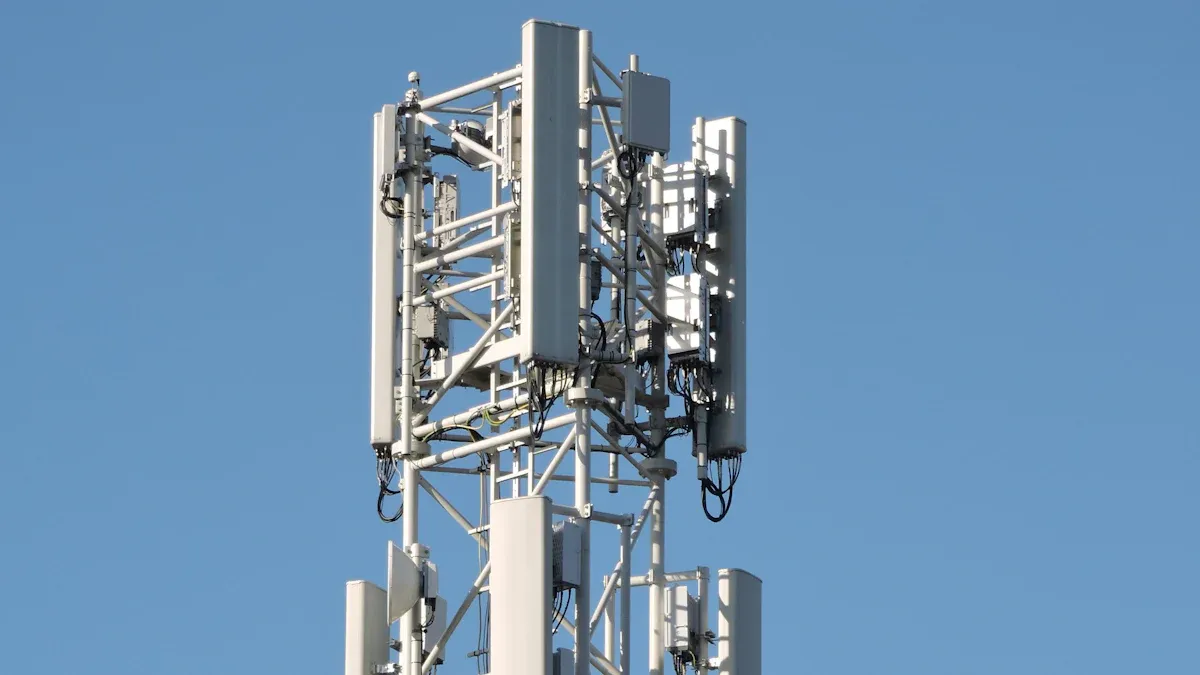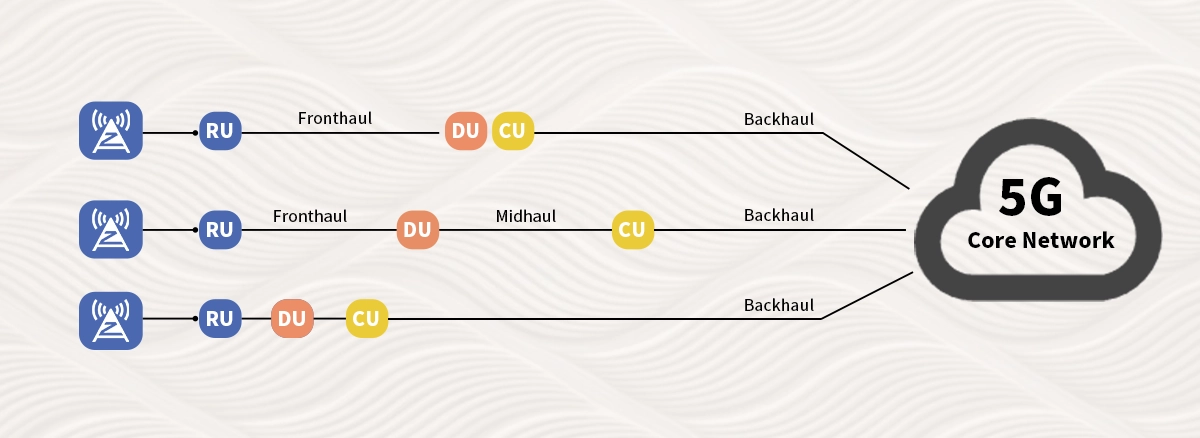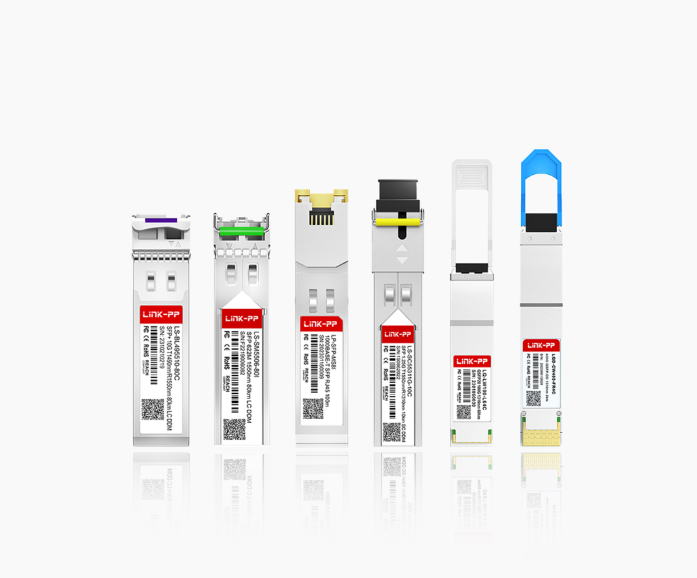
5G fronthaul is the important link between radio units and baseband units in 5g networks. This part lets data move very fast with little delay. Understanding its function, challenges, and the technology enabling it is crucial for anyone deploying or managing next-generation mobile infrastructure. This article dives deep into the world of 5G fronthaul, exploring its significance and the optical solutions making it possible.
➤ Key Takeaways
5G fronthaul links radio units to processing units. This lets data move quickly with little delay. It helps give smooth and steady service.
Fiber optic modules are very important in this process. They change signals into light. This lets data go far and fast. It helps meet high bandwidth needs.
Fronthaul is not the same as backhaul. Fronthaul works on fast links from radio to baseband. Backhaul sends data to the core network. It also handles more traffic.
New technologies like eCPRI, passive optical networks, and wavelength-division multiplexing (WDM) help 5G fronthaul. They make it fast and keep delay low.
Careful testing keeps 5G fronthaul networks quick and steady. It also makes sure timing is right. This helps new things like smart cities and real-time communication.
➤ What is 5G Fronthaul? The Nerve Center of Next-Gen Radio
Traditional mobile networks (3G, 4G) relied heavily on integrated Base Stations. 5G Radio Access Networks (RAN), however, leverage a disaggregated architecture. This splits the processing functions:
Radio Unit (RU): Handles the actual radio transmission and reception at the cell site (antenna tower).
Distributed Unit (DU): Manages real-time, lower-layer baseband processing (like signal encoding/decoding).
Centralized Unit (CU): Handles non-real-time, higher-layer processing and coordination across multiple sites.
Fiber Optic Modules: Allow fast and steady data to move between RUs and DUs.

Fronthaul is the high-capacity, ultra-low-latency connection linking the Radio Unit (RU) directly to the Distributed Unit (DU). It carries the critical, time-sensitive digitized radio signals (I/Q data streams) essential for coordinated features like massive MIMO and beamforming. Think of it as the high-speed express lane carrying the raw ingredients needed to create the 5G user experience.
➤ Why 5G Fronthaul Demands More: Pushing the Limits
The leap to 5G places unprecedented demands on the fronthaul link:
Massive Bandwidth Surge: Wider channel bandwidths (up to 100MHz, even 400MHz with carrier aggregation) and advanced antenna technologies (Massive MIMO with 64T64R or more) exponentially increase the volume of I/Q data needing transport.
Ultra-Low Latency Imperative: Supporting revolutionary applications like autonomous vehicles, industrial automation (IIoT), and augmented reality requires round-trip delays often below 100 microseconds over the fronthaul link itself. Traditional backhaul timings are insufficient.
Stringent Synchronization: Precise time synchronization (phase alignment) between RUs is non-negotiable for techniques like Coordinated Multi-Point (CoMP) and accurate beamforming. Fronthaul must deliver this precision.
Fiber Dependency: Meeting these stringent requirements reliably, especially over longer distances (common in centralized RAN deployments), makes fiber optic cabling the only viable medium. Copper simply cannot scale.
➤ Optical Transceivers: The Engine of High-Speed Fronthaul
This is where advanced optical transceiver technology becomes indispensable. These compact modules convert electrical signals from the RU/DU equipment into optical signals for transmission over fiber, and vice-versa. For 5G fronthaul, specific types are critical:
High-Speed Interfaces: 25 Gigabit Ethernet (25G) SFP28 modules are the baseline for many current deployments. As density and bandwidth needs grow, 50 Gigabit Ethernet (50G) SFP56 and even 100 Gigabit Ethernet (100G) QSFP28 modules are increasingly deployed, especially for higher-order MIMO or aggregated cell sites.
Low Power Consumption: Cell sites often have strict power budgets. Efficient optical transceivers are paramount.
Industrial Temperature Range: Outdoor or poorly conditioned sites demand transceivers that operate reliably in extreme temperatures (-40°C to +85°C).
Reach Requirements: While many fronthaul links are relatively short (<10km), some topologies require longer reaches (up to 20km or 40km). Choosing transceivers with appropriate optical power (like ER or ZR optics) is vital.
CPRI vs. eCPRI: The move from the rigid Common Public Radio Interface (CPRI) to the more efficient Enhanced CPRI (eCPRI) protocol significantly reduces fronthaul bandwidth needs by splitting processing differently. Transceivers must support the required protocol encapsulation (often Ethernet-based for eCPRI).
Passive Optical Networks: Fiber optic modules and links in PON help the network grow as more people join. PON can share bandwidth with many users at once. This helps 5g fronthaul work in crowded areas and with massive MIMO.
WDM and Radio over Fiber: Wavelength Division Multiplexing (WDM) and Radio over Fiber (RoF) are advanced ways to boost 5g fronthaul.
➤ LINK-PP: Delivering Robust Optical Solutions for 5G Fronthaul

Meeting the rigorous demands of 5G fronthaul requires reliable, high-performance optical components. LINK-PP is a trusted provider of cutting-edge optical transceivers specifically engineered for telecommunications infrastructure, including the critical fronthaul segment.
LINK-PP offers a comprehensive portfolio of fronthaul-optimized transceivers, including:
LINK-PP SFP28-25G-LR: High-performance 25G transceiver supporting up to 10km reach, ideal for standard fronthaul links.
LINK-PP QSFP28-100G-LR4: High-density 100G transceiver for aggregating multiple fronthaul streams or supporting extremely high-capacity cell sites (e.g., massive stadium deployments), reaching up to 10km.
Comparison of Common 5G Fronthaul Optical Solutions
Feature | 25G SFP28 (LR) | 100G QSFP28 (LR4) |
|---|---|---|
Speed | 25 Gigabit Ethernet | 100 Gigabit Ethernet |
Typical Reach | Up to 10 km | Up to 10 km |
Best For | Standard cell sites | Site aggregation, Very high capacity |
Density/Port Efficiency | Good | Best (4x25G equiv.) |
Power Consumption | Lower | Higher |
Protocol Support | eCPRI, CPRI Option 8 | eCPRI (Aggregation) |
Example LINK-PP Model |
➤ Overcoming Deployment Challenges
Designing and deploying a robust 5G fronthaul network presents hurdles:
Fiber Availability & Cost: Securing sufficient dark fiber or leasing capacity can be expensive and logistically challenging, especially in dense urban areas.
Latency Management: Every kilometer of fiber adds propagation delay (~5 μs/km). Careful network planning and choosing the right optical transceiver reach profile are essential to stay within budgets.
Synchronization Delivery: Distributing precise timing (Phase, Time, Frequency) over packet-based fronthaul (eCPRI) requires robust solutions like Precision Time Protocol (PTP/IEEE 1588v2) with boundary clocks or transparent clocks integrated into transport equipment.
Maintenance & Troubleshooting: Monitoring the health and performance of active optical components remotely is critical for minimizing downtime.
➤ The Future of Fronthaul: Evolution Continues
Fronthaul technology is not static. Key trends include:
Increased Virtualization (vRAN, O-RAN): Further disaggregation and software-defined networking principles will influence fronthaul management and potentially introduce new functional splits with different bandwidth/latency trade-offs.
Higher Speeds: Adoption of 50G, 100G, and beyond will become more prevalent as bandwidth demands escalate.
Advanced Optics: Coherent optics might find niche use in very long fronthaul scenarios, while continued innovation in high-speed optical transceiver efficiency and cost reduction is ongoing.
➤ Conclusion: Fronthaul – The Unsung Enabler
The 5G fronthaul network is the critical foundation upon which the 5G experience is built. Its demanding requirements for bandwidth, latency, and synchronization necessitate purpose-built solutions. Advanced optical transceivers, like those offered by LINK-PP, are fundamental components enabling operators to deploy robust, scalable, and high-performance fronthaul networks. Choosing the right optical technology partner is paramount for success.
Ready to optimize your 5G fronthaul deployment?
LINK-PP provides industry-leading, reliable optical transceiver solutions specifically designed to meet the rigorous demands of modern 5G networks. Our experts can help you select the perfect high-speed optical transceiver for 5G fronthaul, whether you need cost-effective 25G solutions, extended reach capabilities, or high-density 100G modules.
Explore our range of 5G fronthaul optical transceivers today and ensure your network is built for the future! Visit LINK-PP 5G Optical Solutions ➡




